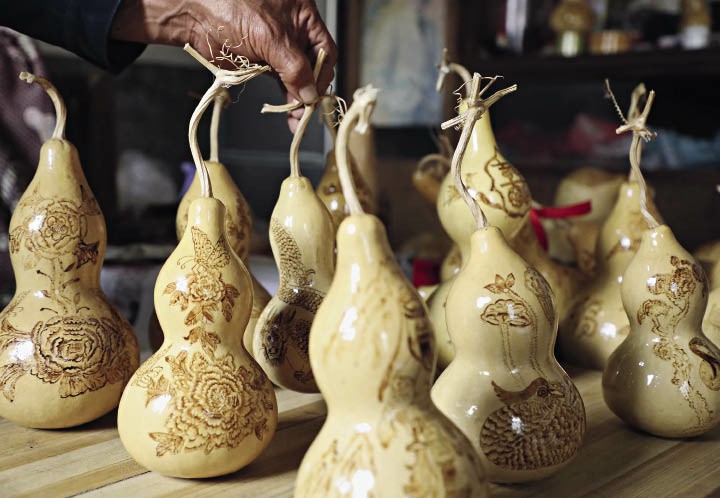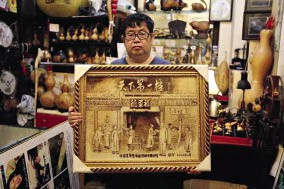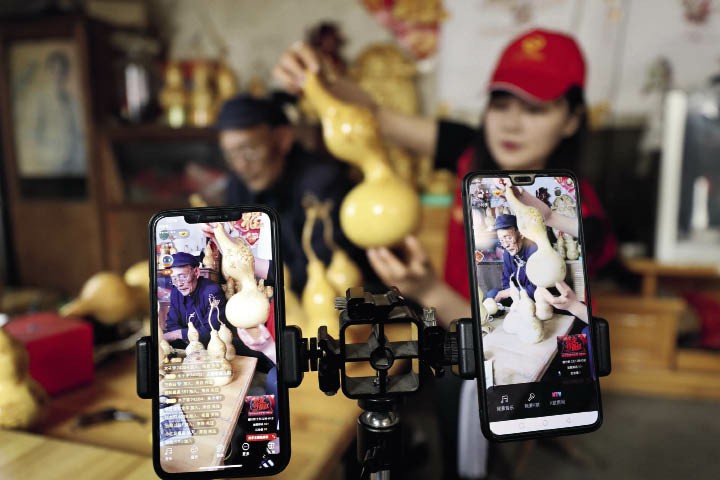Calabash pyrography is an art of putting icing on the cake. In the hands of skilled craftsmen, ordinary bottle gourds can be turned into beautiful collectable pieces of artwork, adding infinite pleasure to Chinese people’s cultural life.
Bottle gourds, or calabash, have long been taken as auspicious objects in China. With a small mouth and a big stomach, they were used as containers in times past. In ancient times, doctors would often hang a bottle gourd in front of their stall, which was originally used to hold medicine. Gradually, bottle gourds evolved into a symbol that represented doctors of traditional Chinese medicine. Meanwhile, the Chinese idiom Xuanhu Jishi (hanging a calabash to help people) came into being, praising the benevolence of medical practitioners who save patients in times of pain.
In folk culture, as the Chinese pronunciation of “bottle gourd” is homophonic with “happy and rich,” it is therefore loved by many people. In addition, as bottle gourd has many seeds, it came to symbolize “thriving of offspring and bountiful grain harvests” and represented the wish of ancient people to have many children and much happiness.
There are many works of art related to bottle gourds in Chinese people’s life, among which bottle gourd pyrography handicraft in Beijing is especially unique and ingenious. It has been added to the list of intangible cultural heritage in Dongcheng District of Beijing and so is now protected by the government.

Calabash pyrography is an art of putting icing on the cake. In the hands of skilled craftsmen, ordinary bottle gourds can be turned into beautiful collectable pieces of artwork, adding infinite pleasure to Chinese people’s cultural life.
Turning the Ordinary into Magic
Bottle gourd pyrography is the art of decorating a bottle gourd by burning a graphic design onto the surface. The technique known as pyrography can be traced back more than 2,200 years to the Qin Dynasty (221-206 BC), but it was not until the end of the Ming Dynasty (1368-1644) that the art was first applied to gourds.
According to legend, the art started accidentally when a group of artists were sending a batch of bottle gourds as tribute to the emperor. The gourds got mildewy on the way as it was during the rainy season. Fearing that they would be punished, the artists came up with the idea of scalding beautiful patterns on the surface of the gourds to conceal the mildewy areas. As expected, the artistic products they made delighted the emperor, and a new kind of art was born.
However, this craft did not receive much public attention until modern times. With the efforts of skilled artists, the art has reached its heyday only in recent times. Bottle gourd pyrography handicrafts featuring historical figures, fairy tales, auspicious patterns, plants, animals, and insects, etc., are popular artworks. Using an electric soldering iron as pen and fire as ink, delightful lifelike figures and animals appear on the surface in an instant.
Bottle gourd pyrography is an art of putting icing on the cake. In the hands of skilled craftsmen, ordinary gourds can be turned into pieces of beautiful collectable artwork, adding infinite pleasure to Chinese people’s cultural life.

Ji Shun is a Chinese artist and inheritor of the intangible cultural heritage of calabash pyrography in Dongcheng District, Beijing.
Procedures
To make a nice gourd pyrography handicraft, three major steps need to be completed: pick a good bottle gourd, design a pattern, and draw on the gourd. These seemingly easy steps may take days or even months to finish!
Step one: select a ripe, golden bottle gourd. There are various kinds of gourds and they always appear beautiful with their natural elegant shapes. Nowadays, with the progress in cultivation technology, you can grow gourds in any shape you desire. This gives artists multiple options from which to choose.
Step two: design creative patterns. To make a good piece of artwork, creativity is always crucial. There is a big difference between painting on gourds and painting on paper as the former has a curved surface, which would lead to the deforming of the pattern.
Skilled artists do not simply transfer a design from a piece of paper onto a gourd. Instead, they take advantage of the natural shape and texture of the gourd, using a heated tool or wire to burn or scorch designs onto them. The result will be a three-dimensional painting that is much more alive than painting on paper. Sometimes, the gourd of a bizarre shape might bring the most unexpected result!
Step three: paint the gourd. When painting gourds, by controlling the speed and force of their “pen,” the electric iron, artists are able to make subtle gradations of color on the gourd surface. The result will be a lively piece of artwork.
In the procedure, the second step is the most important as bottle gourds are not hard to find, and good design ideas easily slip away. Sometimes a gourd might lie on the desk for months before the artist comes up with the final draft design drawing. As for scalding the design onto the gourd, skilled artisans might only need several minutes to get it done.
Today, many craftsmen are engaged in bottle gourd pyrography art, but few can make a fine piece of artwork. To be a skilled gourd pyrographer, a person needs to be: versatile, a first-class painter, a fine judge of bottle gourds, and a good hand at using electric soldering irons. But for ordinary art lovers, Beijing’s Baigongfang Handicrafts Museum’s training classes will surely be able to meet their needs.

On May 7, 2020, a live-streaming team helps an old farmer, Yin Chuanming, to sell his calabash pyrography artworks at his home in Sishanzi Village of Linyi City in east China’s Shandong Province.
Life as a Gourd Pyrographer
In Beijing’s bottle gourd pyrography circle, Ji Shun is quite famous. Ji, now in his late 60s, is a senior Chinese arts and crafts artist and an inheritor of the intangible cultural heritage of bottle gourd pyrography in Dongcheng District.
Ji used to work in his own studio at Baigongfang Handicrafts Museum, but this year he moved his studio back to his home in Fengtai District due to renovations being made at the museum. In a small bedroom of his apartment, his gourd works, calligraphy, and painting works are hanging all over the wall, giving it the appearance of an art gallery.
Ji spent most of his life doing journalism. Then around the year 2000, the company he was working at went bankrupt due to the financial crisis which was sweeping through Asia back then. As a result, Ji opened his own gallery in Beijing with the dream of being an artist. It was at this gallery that he accidentally came in contact with the art of bottle gourd pyrography.
Ji is skillful at traditional Chinese realistic painting and calligraphy. In his spare time, he also writes poems. These hobbies have nourished his career from the very beginning of being a fledgling gourd pyrography artist. The first bottle gourds he painted were an instant success, giving him the chance to take them to overseas exhibitions as a member of the government art troupe later.
When asked what the best feature of his gourd works is, Ji replies that he just follows the natural shape of the bottle gourd to apply wild imagination. Besides, in terms of motif, instead of only using traditional Chinese realistic paintings, which most artisans do, he borrows elements from Western painting techniques to vary the style of his works.
In his early years, Ji liked to make unique works from bottle gourds that had strange shapes. But gradually, he realized that gourds with an ordinary shape are the big challenge to work on. Sometimes, he just holds a new gourd and stares at it under the light before doing anything with it. “While the gourd revolves in my hand, the changes in the shape of its shadows always inspire me,” Ji says.
“At first, my wife and I drew on bottle gourds only for fun. She is a better painter of realistic painting than I am. For a period of time, we both became immersed with this art. Then naturally I picked it up as one of my careers,” Ji looked at his cherished gourds and became lost in thought.
Ji’s wife, Xu Qing, learned from his father, Xu Yongkang, a master of traditional Chinese realistic painting, how to paint flowers and birds, and was an inheritor of hand-painted silks, another intangible cultural heritage of Beijing. In Ji’s eyes, his wife’s paintings are more meticulous than his own. For years, the congenial couple have worked together and influenced each other.
“We discussed the crafts we did together. While that sometimes turned into a quarrel, most of the time we inspired each other,” He recalled.
Earlier this year, Ji’s wife passed away, leaving a great vacancy in his heart. But despite his pain, he says he will carry forward their mutual art career. He has a wish to organize an exhibition one day to share with art lovers what he and his wife have devoted their lives to.